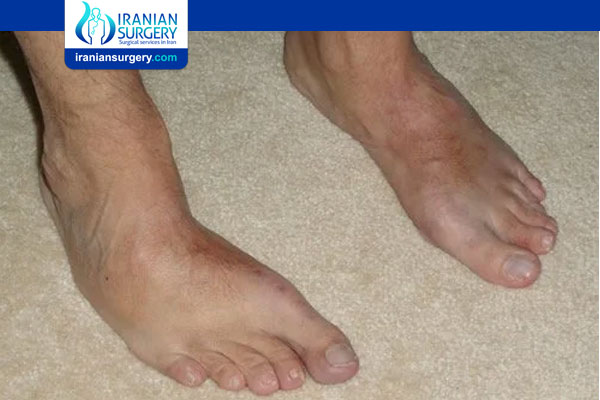Clubfoot Surgery in Adults
Clubfoot Surgery in Adults
Clubfoot is a condition that is commonly found in newborns. The deformity, however, may develop and persist into adulthood. While it can look serious when first spotted, the new advancements in treatments make correcting clubfoot very safe. Although the condition is not life-threatening, if it is not treated immediately, it can lead to long-term problems.
What Is Clubfoot?
Talipes equinovarus, commonly known as clubfoot, is a condition that most often develops at birth where one, or both feet, turns inward due to short or tight tendons that connect the foot bone to the leg muscles. Often, this problem is addressed and corrected shortly after birth, but sometimes treatment is unsuccessful, and the clubfoot may return at some point during adulthood. Additionally, clubfoot may appear in adults due to the following conditions:
. Cerebral palsy
. Spina bifida
. Meningitis
. Spinal trauma
What Are the Symptoms of Clubfoot in Adults?
For adults, the effects of clubfoot can often be painful and severely affect one’s daily life. The symptoms of the debilitating condition typically include:
. Difficulty walking/exercising
. Walking on the sides of the foot
. Spine pain
. Pain in the calf
. Pain in the arch of the foot
. Joint issues in the knee, hips, and ankles
What Are the Treatment Options for Clubfoot in Adults?
Pre-Ponseti Treatment for Clubfoot
Modern treatment for clubfoot follows the Ponseti Method, a mainly non-surgical treatment involving weekly massage and plaster cast application to gradually improve the position of the foot. This is usually followed by a minor procedure known as a tenotomy and fitting of a foot abduction brace to maintain the correction.
Before the Ponseti method, clubfoot was often treated with extensive surgery on the bones to alter the position of the foot. This was common practice in the 70’s, 80’s and 90’s.
There were many different surgical approaches to correcting clubfoot, and most were focussed on correcting the bone deformity and improving the appearance and functionality of the foot. Common approaches before the widespread use of the Ponseti Method included:
. Postero-medial release (PMR), was an extensive surgery to release tight/contracted soft tissues associated with clubfoot.
. A patient specific, surgical approach; aimed at gradually correcting each aspect of the bone deformities associated with the condition.
Surgical Treatments
Some adults have residual deformities and surgery can be remarkably effective even in adulthood, especially if there is a residual deformity that has not been completely corrected. In other cases, when painful degeneration in the joints is present, an arthrodesis or fusion may be the best treatment to manage pain.
. Surgery to the ankle is usually only considered when all other treatments have been ineffective. There are several options for ankle surgery;
. Ankle fusion, where the joint is fused in a standing position and pinned. It may be possible to perform the procedure using keyhole surgery. A cast would need to be worn for several weeks and following this, it should be possible to wear everyday shoes and walk normally.
. Triple fusion involves the fusion of three joints (the talonavicular, subtalar and calcaneocuboid joints) which are pinned using plates or screws.
. An ankle replacement replaces the worn out ends of the tibia and talus bones with plastic or metal and will still allow for the movement of the ankle joint. It may be necessary to use crutches for a few weeks following surgery. The procedure isn’t as common as hip or knee replacement, but it is thought the new joint can last for ten to fifteen years.
Opting for a surgical approach to ankle pain has advantages and disadvantages; it can offer long-lasting pain relief, reduce the need for regular medication and improve foot function and mobility. However, replacement joints are not long lasting and further surgery may be required.
Ankle fusion surgery restricts joint movement but may offer greater mobility due to a reduction in pain. Occasionally an ankle fusion may lead to a ‘non-union’, where the bones do not join properly, and further surgery may be required. Crutches may be required for several weeks after surgery and some operations, such as ankle fusion require reduced weight bearing for several months, which may impact on day-to-day life and work. Other complications include excessive swelling, increased stiffness or possible infection.
The combination of treatment options most suited to an individual will vary and depend on the severity of the impact on a person’s life. Some options may not be suitable for everyone and the hospital or GP will be able to advise on the best course of action for your individual circumstances.
Preventative Measures
Non-impact activities are generally particularly good for adults with surgically treated feet. Activities such as swimming, cycling and cross training as well as walking are recommended.
Running and other impact activities are more likely to generate symptoms therefore it is advisable to avoid these types of activities, especially if you have experienced pain in your foot or feet. Maintaining a healthy weight may also improve ankle pain by reducing pressure on the joint.
About Iranian Surgery
Iranian surgery is an online medical tourism platform where you can find the best orthopedic surgeons in Iran. The price of Clubfoot Surgery in Iran can vary according to each individual’s case and will be determined by an in-person assessment with the doctor.
For more information about the cost of Clubfoot Surgery in Iran and to schedule an appointment in advance, you can contact Iranian Surgery consultants via WhatsApp number 0098 901 929 0946. This service is completely free.
Source:
https://advancedorthosurgeons.com/uncategorized/clubfoot-solutions/
https://www.stepsworldwide.org/conditions/talipes-clubfoot-for-adults/


